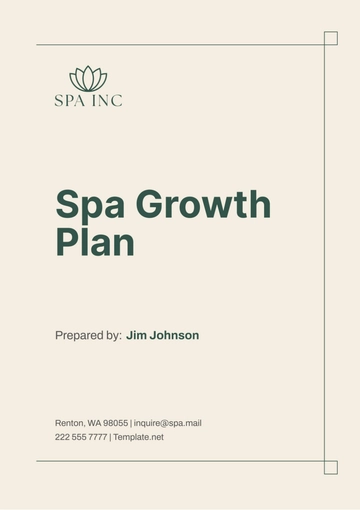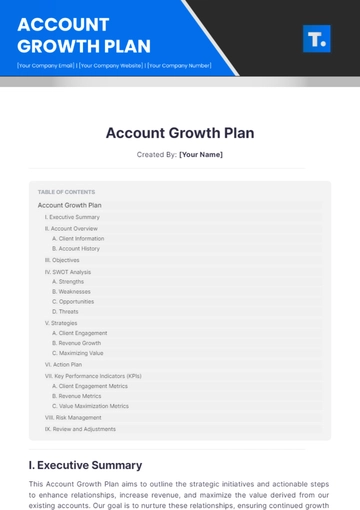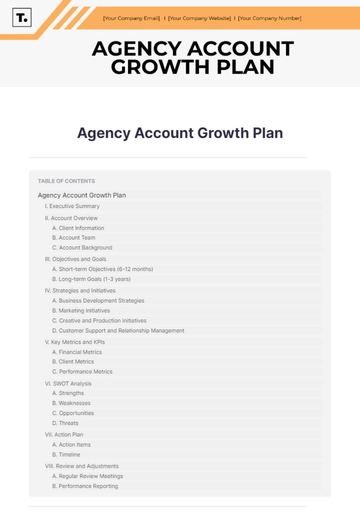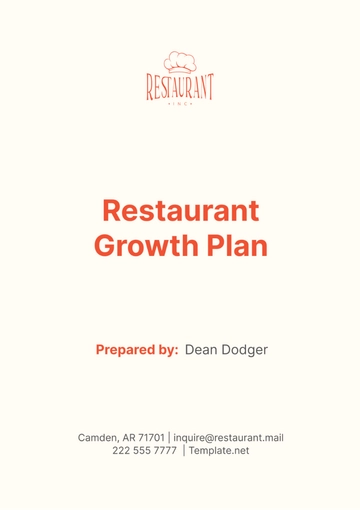Free Restaurant Growth Plan
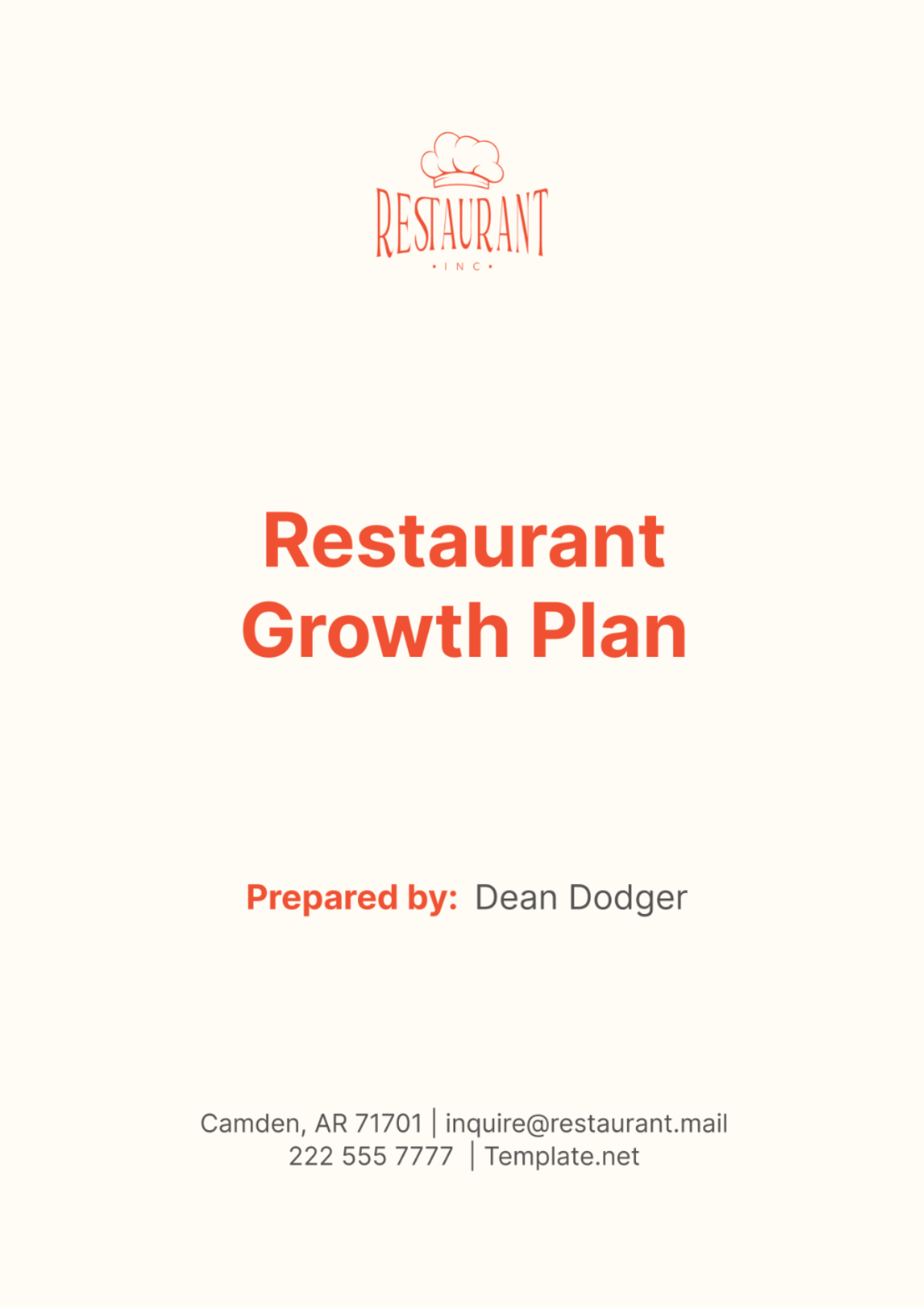
I. Executive Summary
A. Overview of the Restaurant
[Your Company Name], established in [Year], has become a beloved fixture in downtown with its fusion of international flavors and cozy ambiance. Our commitment to quality ingredients and exceptional service has earned us a loyal following and positive reviews.
B. Summary of Growth Objectives
Over the next two years, [Your Company Name] aims to expand its footprint by opening two new locations in high-traffic areas, increase revenue by 30%, and solidify its position as a go-to dining destination in the region.
C. Key Strategies for Achieving Growth
Our growth strategy hinges on strategic expansion, menu optimization, and targeted marketing efforts. By capitalizing on our strengths and addressing areas for improvement, we aim to drive sustainable growth and profitability.
II. Market Analysis
A. Industry Overview
The restaurant industry in our region has experienced steady growth, fueled by an increase in disposable income and a thriving tourism sector. Despite recent challenges, the demand for dining out remains strong, presenting ample opportunities for growth.
B. Market Trends and Opportunities
Consumer preferences are shifting towards healthier, more sustainable dining options, creating opportunities for [Your Company Name] to diversify its menu and attract a broader customer base. Additionally, the rise of food delivery services offers a new avenue for revenue generation.
C. Target Customer Demographics
Our target customers include urban professionals, families, and tourists seeking a unique dining experience with a focus on quality and authenticity. By understanding their preferences and behavior, we can tailor our offerings and marketing efforts to better resonate with our audience.
D. Competitive Analysis
While there is competition in the market, [Your Company Name] sets itself apart with its diverse menu offerings and warm, inviting atmosphere. However, we recognize the need to stay vigilant and continuously innovate to maintain our competitive edge.
E. SWOT Analysis
Strengths | Weaknesses | Opportunities | Threats |
|---|---|---|---|
Strong brand reputation | Limited marketing efforts | Expansion into new locations | Intense competition |
Loyal customer base | Lack of online ordering | Menu diversification | Economic downturns |
Unique menu offerings | Growing demand for healthy options | Negative reviews or customer complaints |
III. Financial Analysis
A. Current Financial Performance
[Your Company Name] has achieved consistent revenue growth, with an average annual growth rate of 15% over the past three years. Our current annual revenue stands at $[0] million, with a net profit margin of 10%.
B. Revenue and Profitability Projections
Based on our growth objectives, we project a revenue increase to $[0] million within the next two years, driven by the opening of new locations and menu optimizations. We anticipate a corresponding increase in profitability, with a net profit margin target of 12%.
C. Budget for Growth Initiatives
We have allocated $[000,000] for the opening of two new locations, $[000,000] for menu revamp and marketing campaigns, and $[00,000] for technology upgrades and operational improvements.
D. Funding Requirements
To finance our growth initiatives, we will explore various funding options, including bank loans, investors, and reinvesting profits. We aim to secure the necessary capital to support our expansion plans while maintaining financial stability.
IV. Brand Development
A. Brand Identity and Values
[Your Company Name] prides itself on its commitment to using fresh, locally sourced ingredients and providing a warm and welcoming dining experience for all patrons. Our brand values of quality, authenticity, and hospitality are at the core of everything we do.
B. Unique Selling Proposition (USP)
Our unique selling proposition lies in our diverse menu offerings, which blend global flavors with locally sourced ingredients to create a truly unique dining experience. We strive to offer something for everyone, whether they're craving comfort food classics or adventurous culinary creations.
C. Brand Positioning in the Market
We position ourselves as a neighborhood eatery that offers high-quality food at affordable prices, with a focus on community engagement and customer satisfaction. Our goal is to become the go-to dining destination for locals and visitors alike, known for our delicious food and welcoming atmosphere.
D. Branding Strategy for Growth
Our branding strategy focuses on reinforcing our brand values and unique selling proposition through consistent messaging across all marketing channels. We will leverage social media, email marketing, and local partnerships to amplify our brand presence and attract new customers.
V. Menu Optimization
A. Menu Analysis
We have conducted a comprehensive analysis of our menu performance, identifying top-selling items, profit margins, and customer preferences. This analysis has highlighted opportunities to streamline our menu, remove underperforming items, and introduce new dishes that cater to evolving consumer tastes.
B. Menu Engineering
By implementing menu engineering techniques, we aim to optimize our menu layout, pricing, and item placement to maximize profitability and customer satisfaction. This involves identifying high-margin items, promoting them effectively, and adjusting pricing and portion sizes where necessary.
C. New Menu Development
Our new menu will feature a mix of customer favorites, seasonal specials, and innovative dishes that showcase the best of global and local flavors. We will work closely with our culinary team to develop recipes that highlight fresh, seasonal ingredients and align with current food trends.
D. Pricing Strategy
Our pricing strategy will balance affordability with quality, ensuring that our offerings remain competitive in the market while still providing value for our customers. We will conduct pricing analyses and monitor market trends to adjust our pricing strategy as needed to maximize revenue and profitability.
VI. Marketing and Promotion
A. Marketing Objectives
Our marketing objectives are to increase brand awareness, drive foot traffic to our restaurants, and generate repeat business through targeted marketing campaigns and promotions. We aim to create a strong brand presence both online and offline, engaging with our target audience through various channels.
B. Targeted Marketing Channels
We will leverage a mix of digital and traditional marketing channels to reach our target audience, including social media advertising, email marketing, local print ads, and community events. By targeting our marketing efforts strategically, we can effectively reach our desired demographic and drive engagement with our brand.
C. Advertising and Promotion Campaigns
We will launch seasonal promotions, special events, and loyalty programs to incentivize customer visits and increase sales. These campaigns will be designed to create buzz, generate excitement, and encourage trial of new menu items, ultimately driving revenue growth and customer loyalty.
D. Customer Relationship Management (CRM)
We will implement a CRM system to capture customer data, track purchasing behavior, and personalize marketing communications. By segmenting our customer base and tailoring our messaging to their preferences, we can enhance the customer experience and foster long-term relationships with our patrons.
E. Loyalty Programs
We will introduce a tiered loyalty program offering rewards, discounts, and exclusive perks to our most loyal customers. By incentivizing repeat visits and rewarding customer loyalty, we can increase customer retention and lifetime value, driving incremental revenue for the business.
VII. Expansion Plans
A. Location Analysis and Selection
We have identified two prime locations for new restaurants, based on market demographics, foot traffic, and competition analysis. These locations offer strong growth potential and strategic positioning within our target market, aligning with our expansion objectives.
B. New Store Opening Timeline
We aim to open the first new location within the next six months, followed by the second location within the subsequent year. Our expansion timeline is carefully planned to ensure sufficient time for site selection, lease negotiation, and build-out, while also allowing for comprehensive staff training and marketing preparation.
C. Franchising or Licensing Opportunities
As part of our long-term growth strategy, we will explore franchising or licensing opportunities to expand our brand presence beyond our current region. This approach offers scalability and potential revenue streams while leveraging local expertise and resources in new markets.
D. International Expansion Strategy
While not an immediate priority, we will evaluate the feasibility of international expansion in the long term, considering factors such as market demand, regulatory requirements, and cultural considerations. International expansion presents exciting opportunities for growth but requires careful planning and strategic partnerships to succeed.
VIII. Operational Improvements
A. Streamlining Processes and Workflow
We will conduct a thorough review of our operational processes, from kitchen operations to customer service protocols, to identify areas for streamlining and efficiency improvements. By optimizing workflows and eliminating bottlenecks, we aim to enhance overall productivity and service quality.
B. Staff Training and Development
Investing in staff training and development is crucial to maintaining service standards and delivering exceptional customer experiences. We will implement comprehensive training programs covering food safety, hospitality skills, and menu knowledge to ensure that our team is well-equipped to meet customer expectations.
C. Technology Integration
We will leverage technology solutions such as upgraded POS systems, online reservation platforms, and mobile ordering apps to streamline operations and improve customer convenience. By embracing technology, we can enhance order accuracy, reduce wait times, and capture valuable customer data for personalized experiences.
D. Supply Chain Optimization
Collaborating closely with our suppliers, we will optimize our supply chain management practices to minimize waste, reduce costs, and ensure consistent product quality. This includes implementing just-in-time inventory systems, sourcing locally whenever possible, and negotiating favorable supplier contracts.
IX. Customer Experience
A. Service Standards and Training
Delivering exceptional customer service is a cornerstone of our brand identity. We will uphold high service standards through ongoing staff training, performance incentives, and regular customer feedback mechanisms. Our goal is to create memorable dining experiences that keep customers coming back.
B. Ambiance and Atmosphere
We will invest in enhancing the ambiance and atmosphere of our restaurants to create a welcoming and comfortable environment for our guests. This includes updating decor, improving lighting and music selections, and ensuring cleanliness and maintenance standards are consistently met.
C. Feedback Mechanisms
Open communication with our customers is essential for continuous improvement. We will implement various feedback mechanisms, such as comment cards, online surveys, and social media listening tools, to gather insights into customer preferences and address any concerns promptly.
D. Quality Assurance Measures
Maintaining rigorous quality assurance measures is critical to upholding our brand reputation. We will conduct regular audits and inspections to ensure food safety standards are met, monitor product quality and consistency, and address any issues promptly to maintain customer trust.
X. Sustainability Initiatives
A. Environmental Impact Assessment
We will conduct a comprehensive assessment of our environmental impact, from energy consumption to waste generation, to identify opportunities for improvement. This includes evaluating our carbon footprint, water usage, and waste management practices.
B. Sustainable Sourcing Practices
As part of our commitment to sustainability, we will prioritize sourcing ingredients from local suppliers and farms that adhere to sustainable farming practices. This includes selecting suppliers who prioritize ethical sourcing, minimize packaging waste, and support biodiversity conservation efforts.
C. Waste Reduction Programs
We will implement waste reduction programs aimed at minimizing food waste, recycling packaging materials, and diverting organic waste from landfills. This includes portion control measures, composting initiatives, and partnerships with food rescue organizations to redistribute surplus food to those in need.
D. Community Engagement
Engaging with our local community is integral to our sustainability efforts. We will actively participate in community events, support local charities, and collaborate with environmental organizations to raise awareness and promote sustainable practices. By actively contributing to our community, we aim to create positive social impact and foster long-term relationships with our stakeholders.
XI. Risk Management
A. Identification of Potential Risks
We will conduct a thorough risk assessment to identify potential risks and vulnerabilities that could impact our business operations. This includes internal risks such as staff turnover and supply chain disruptions, as well as external risks such as economic downturns and natural disasters.
B. Mitigation Strategies
Once risks are identified, we will develop proactive mitigation strategies to minimize their impact and ensure business continuity. This may include implementing contingency plans, diversifying supply chain sources, and securing appropriate insurance coverage to protect against unforeseen events.
C. Contingency Planning
In addition to mitigation strategies, we will develop comprehensive contingency plans outlining specific steps to take in the event of various risk scenarios. This includes establishing communication protocols, identifying alternative suppliers or vendors, and allocating resources to address emergency situations effectively.
XII. Implementation Plan
A. Timeline for Execution of Growth Initiatives
We will develop a detailed timeline outlining key milestones and deadlines for the implementation of our growth initiatives. This includes specific timelines for opening new locations, rolling out menu changes, launching marketing campaigns, and implementing operational improvements.
B. Responsibilities and Accountabilities
Clear roles and responsibilities will be assigned to team members involved in executing the growth plan, with designated project leads overseeing each initiative. Regular progress updates and checkpoints will be established to monitor progress and address any issues or roadblocks promptly.
C. Key Performance Indicators (KPIs) for Tracking Progress
We will define key performance indicators (KPIs) to track the success of our growth initiatives and measure progress towards our goals. This includes metrics such as revenue growth, customer satisfaction scores, employee retention rates, and sustainability targets.
D. Monitoring and Evaluation Mechanisms
Ongoing monitoring and evaluation will be conducted to assess the effectiveness of our growth plan and make adjustments as needed. This includes regular performance reviews, data analysis, and stakeholder feedback sessions to ensure that we remain agile and responsive to changing market dynamics.
- 100% Customizable, free editor
- Access 1 Million+ Templates, photo’s & graphics
- Download or share as a template
- Click and replace photos, graphics, text, backgrounds
- Resize, crop, AI write & more
- Access advanced editor
Discover the ultimate solution for restaurant owners with Template.net's editable and customizable Restaurant Growth Plan Template. Crafted with precision, this template features an intuitive AI Editor Tool, empowering users to tailor their growth strategies effortlessly. Unlock success and expansion opportunities with this comprehensive tool, exclusively designed for restaurateurs aiming for prosperity.
You may also like
- Finance Plan
- Construction Plan
- Sales Plan
- Development Plan
- Career Plan
- Budget Plan
- HR Plan
- Education Plan
- Transition Plan
- Work Plan
- Training Plan
- Communication Plan
- Operation Plan
- Health And Safety Plan
- Strategy Plan
- Professional Development Plan
- Advertising Plan
- Risk Management Plan
- Restaurant Plan
- School Plan
- Nursing Home Patient Care Plan
- Nursing Care Plan
- Plan Event
- Startup Plan
- Social Media Plan
- Staffing Plan
- Annual Plan
- Content Plan
- Payment Plan
- Implementation Plan
- Hotel Plan
- Workout Plan
- Accounting Plan
- Campaign Plan
- Essay Plan
- 30 60 90 Day Plan
- Research Plan
- Recruitment Plan
- 90 Day Plan
- Quarterly Plan
- Emergency Plan
- 5 Year Plan
- Gym Plan
- Personal Plan
- IT and Software Plan
- Treatment Plan
- Real Estate Plan
- Law Firm Plan
- Healthcare Plan
- Improvement Plan
- Media Plan
- 5 Year Business Plan
- Learning Plan
- Marketing Campaign Plan
- Travel Agency Plan
- Cleaning Services Plan
- Interior Design Plan
- Performance Plan
- PR Plan
- Birth Plan
- Life Plan
- SEO Plan
- Disaster Recovery Plan
- Continuity Plan
- Launch Plan
- Legal Plan
- Behavior Plan
- Performance Improvement Plan
- Salon Plan
- Security Plan
- Security Management Plan
- Employee Development Plan
- Quality Plan
- Service Improvement Plan
- Growth Plan
- Incident Response Plan
- Basketball Plan
- Emergency Action Plan
- Product Launch Plan
- Spa Plan
- Employee Training Plan
- Data Analysis Plan
- Employee Action Plan
- Territory Plan
- Audit Plan
- Classroom Plan
- Activity Plan
- Parenting Plan
- Care Plan
- Project Execution Plan
- Exercise Plan
- Internship Plan
- Software Development Plan
- Continuous Improvement Plan
- Leave Plan
- 90 Day Sales Plan
- Advertising Agency Plan
- Employee Transition Plan
- Smart Action Plan
- Workplace Safety Plan
- Behavior Change Plan
- Contingency Plan
- Continuity of Operations Plan
- Health Plan
- Quality Control Plan
- Self Plan
- Sports Development Plan
- Change Management Plan
- Ecommerce Plan
- Personal Financial Plan
- Process Improvement Plan
- 30-60-90 Day Sales Plan
- Crisis Management Plan
- Engagement Plan
- Execution Plan
- Pandemic Plan
- Quality Assurance Plan
- Service Continuity Plan
- Agile Project Plan
- Fundraising Plan
- Job Transition Plan
- Asset Maintenance Plan
- Maintenance Plan
- Software Test Plan
- Staff Training and Development Plan
- 3 Year Plan
- Brand Activation Plan
- Release Plan
- Resource Plan
- Risk Mitigation Plan
- Teacher Plan
- 30 60 90 Day Plan for New Manager
- Food Safety Plan
- Food Truck Plan
- Hiring Plan
- Quality Management Plan
- Wellness Plan
- Behavior Intervention Plan
- Bonus Plan
- Investment Plan
- Maternity Leave Plan
- Pandemic Response Plan
- Succession Planning
- Coaching Plan
- Configuration Management Plan
- Remote Work Plan
- Self Care Plan
- Teaching Plan
- 100-Day Plan
- HACCP Plan
- Student Plan
- Sustainability Plan
- 30 60 90 Day Plan for Interview
- Access Plan
- Site Specific Safety Plan




